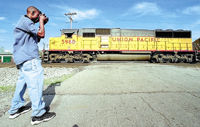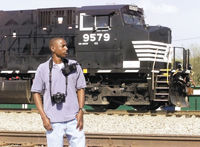This website has been archived from TrainWeb.org/columbusrailfan to TrainWeb.US/columbusrailfan.
Ohio's Greatest Home Newspaper |
So To Speak Saturday, May 12, 2001 Joe Blundo As traffic obstructions go, trains are one of the more interesting things that can make you late for an appointment. Most of us just curse as they pass, but not Stephen Mosley. He's a "railfan," which is something like being a bird-watcher except that railfans train their eyes on passing freights instead of pileated woodpeckers. They report sightings and keep records, too. Recently, I hung out with Mosley at the railroad crossing on Cooke Road, just east of Indianola Avenue, in Clintonville. It's a popular railfan spot because you can park there without being on railroad property, a no-no. Clintonville residents who are less enamored of railroads are meeting at 6:30 p.m. Monday at the Whetstone Park of Roses shelter house to air their gripes about increased train traffic and the noise and inconvenience that comes with it. For Mosley and his fellow railfans, though, there's no such thing as too many trains. I asked Mosley to offer advice on what to look for while stuck in traffic by a train. You're not going anywhere anyway, so why not enjoy the passing scenery? One thing to watch for, Mosley said, are "foreign trains." The black engines of Norfolk Southern (railfans call them "catfish" because the white stripes on the front end resemble whiskers from a distance) and the gray-yellow-blue engines of CSX dominate the tracks in central Ohio because they are the dominant railroads here. So, Mosley was excited when he looked south along the tracks near the Cooke Road crossing and saw something yellow approach. That's the signature color of the Union Pacific, one of the dominant railroads of the West. "This is what makes a railfan happy, right here," Mosley shouted as a Union Pacific freight thundered by. "To see something that's not native to your area." Even the horn sounds different, Mosley pointed out. (For a complete discussion, find railfans who specialize in horn tones. They exist.) Another foreign train you might see here is the BNSF (Burlington Northern Santa Fe), another of the big Western railroads. Railfans call their orange engines "pumpkins." Mosley is a fan of the defunct Conrail system, which was absorbed by Norfolk Southern and CSX in 1999. The two railroads are repainting Conrail's blue engines, but not quickly. You'll often see Conrail engines flash by in central Ohio, like blue ghosts. Railfans call the insignia of defunct railroads "fallen flags." Many railfans have specific areas of interest. "I'm a paint guy," said Mosley, whose specialty is engine paint schemes. He maintains a Web site (http://www.trainweb.us/columbusrailfan/) where he posts photos of Conrail engines and how they look now that they've been repainted by their new owners. With the help of other railfans on the Web, he is attempting to document every Conrail "repaint." If you have to ask why it matters that CSX 801 is the repainted Conrail 4104, you're obviously not a railfan. Speaking of engines, most of the ones pulling freight were manufactured by EMD (the Electro-Motive Division of General Motors) or by General Electric. While stuck in traffic, why not learn to identify which is which? At the risk of oversimplifying a complicated topic, I'll pass on the quick tips of Mosley and John Sirback, another railfan, for identifying engine makes. EMDs usually have circular radiator fan housings on their roofs. GE engines usually don't. But they have large rear radiators that appear wedge-shaped as they approach you, like folded wings. An engine also carries a manufacturer's plate that tells you who made it, but you have to be close to the train to read it. And if you're close to the train, you may be trespassing on railroad property, not to mention in imminent danger of being "peeled." That's railfan lingo for getting run over by a train. Feel powerful in your SUV? The engine passing you probably weighs close to 400,000 pounds, has 4,000 horsepower and sports a fuel tank capable of holding nearly 5,000 gallons. Railfans like to say that a train hitting a car is analogous to a car hitting an empty soda can. So the engines are obvious points of interest, but even after they have passed, there are many things to gawk at. Among the most interesting freight cars are the tankers, which carry all manner of exotic substances that could kill you. The contents are identified by color-coded placards. Orange placards, for example, indicate explosives. Poisons are white. Radioactive materials are yellow and white with the symbol for radioactivity. If you want to get more specific, check out Mosley's Web site link to a federal government directory of hazardous substances, which are identified by numbers on tank cars. You can download the list and keep it in your car. Then you will know that 2394 is isobutyl propionate, a flammable substance. Freight cars also are interesting because railroads often don't repaint them. They continue to sport the logos of defunct companies -- Chessie, Penn Central, B&O, etc. A passing freight is like a mobile lesson in the history of business failure. Graffiti artists also are attracted to freight cars. Mosley pointed out the work of one of the legendary ones: Smokin' Joe. Smokin' Joe tags auto-parts carriers (long, rectangular enclosed cars) with a distinctive logo of a smoking train. He also numbers his work. While train-watching with Mosley, we saw five passing freights, and at least four of them had a Smokin' Joe car. One was number 17,487, the highest Mosley had ever seen. Joe is a well-organized vandal. Mosley keeps track of rail traffic with a scanner and a map that he has annotated with all the track mileposts in the Columbus area. With those two tools, he can usually find a train. He once drove all the way to Middletown on rumors of an SD-80MAC, an unusually big locomotive made by EMD. (Railfans have a way of tracking trains via scanner and phone.) He waited six hours for it to pass by, then followed it for 10 miles, snapping pictures. Remember that the next time you're fuming impatiently while a train clears a crossing. One man's traffic jam is another man's photo opportunity. Joe Blundo is an Accent columnist. |
HOME | SEARCH | JOBS | CLASSIFIEDS | BUSINESS DIRECTORY | SUBSCRIBE | CONTACT US
Copyright © 2001, The Columbus Dispatch
















